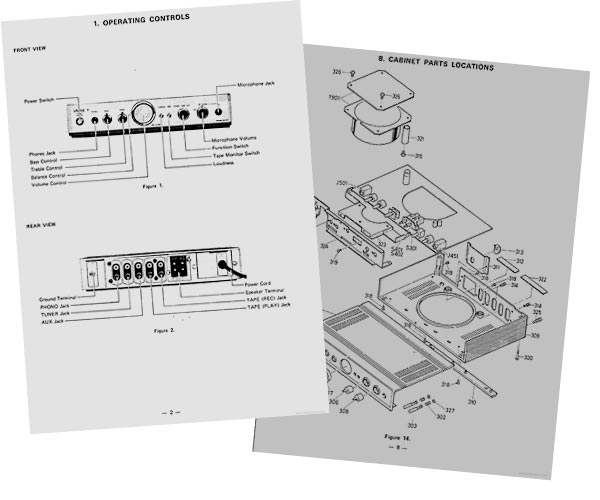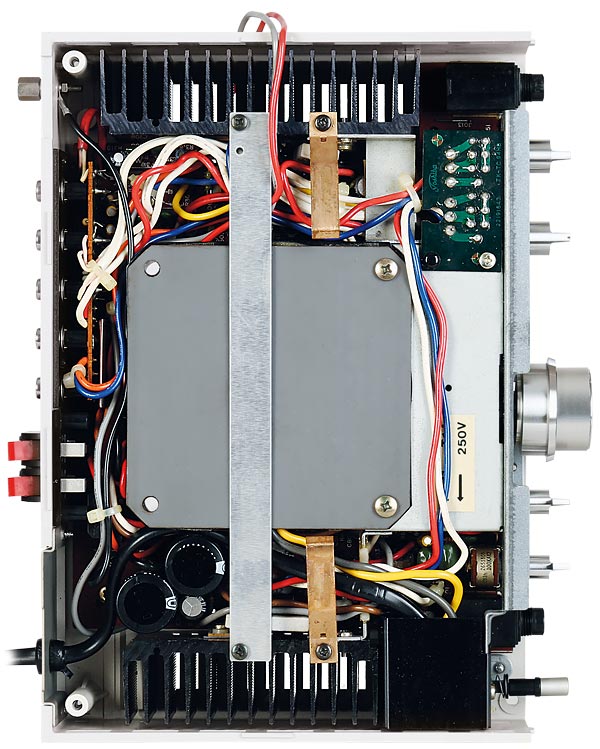Aurex SB-A10 amplifier Page 2
![]() Tim Listens
Tim Listens
Whether 20W per channel is sufficient for serious listening depends as much on musical taste, room size and loudspeaker choice as it does on amp design. That said, the SB-A10 hangs together reasonably well at high volumes. Using a CD player with a standard 2V output connected to the auxiliary input on the SB-A10, the usable headroom seems to run out with the pointer of the volume knob at 12 o'clock. The rest of the range is best viewed as surplus gain for quiet LP pressings, etc.
Perhaps unsurprisingly, it sounds like it is the power supply that is first to give once the limit is reached, with the bass taking on an odd hollow quality as a prelude to rapidly increasing distortion. Up until this point the SB-A10 neatly sidesteps the 'small amplifier' sound that one often observes in low-powered equipment, heard as turgid dynamics and a lack of any real extension at either tonal extreme. Also, being fabricated from discrete components it avoids the excessively conservative sound that hybrid chip amplifiers of this era can display. DC loudspeaker coupling gives the SB-A10 a fast, tightly focused sound.

Used with efficient speakers – I chose the Technics SB-7000s [HFN Jan '21] – the tiny SB-A10 played 'Possible Worlds' by The Shamen [One Little Indian TPLP72CDE] with enough gusto to turn my listening room into an imaginary 1990s rave in an abandoned warehouse. The sound had all the scale, drive and power this illusion demands. More tracks of a similar genre followed, but even after several hours of flat-out use the amplifier was no more than slightly warm to the touch.
Serious Sounds
Hearing Mari Fujiwara play Haydn's Concerto in D [Denon DC-8121] was also a revelation. Her violoncello possessed a beautiful, chesty character and total smoothness, proving the SB-A10 to be a serious amplifier for serious listeners. Exceptional clarity and a complete absence of self-generated noise was also noted, as was the transparency of the presentation.
Usually I like to balance such praise with at least a small criticism, but this proved to be a difficult unit to fault. Yes, absolute bass extension and overall refinement possibly failed to reach the elevated standard set by the SY-C15/SC-M15 pre/power combination, but this is hardly a surprise given that the SB-A10 cost around a quarter of its price when new. Viewed in isolation, this design more than holds its own.
With a less forgiving loudspeaker load the story may be a different one given the SB-A10's limited power supply capacity. There are some punishingly power-hungry miniature and sub-miniature speakers out there that may seem a natural match if space is limited. But remember that these may not integrate with the amp so well. Having said that, it gave good results with the B&O Beovox C30 and Technics SB-F1 designs I tried. 'Proper' hi-fi loudspeakers don't come much more compact than either of these!

Even if the SB-A10 were not as miniaturised as it is, it would still rank as a fine amplifier, inasmuch as one would have had to spend a lot more to bring a worthwhile improvement. Although not quite perfect, it certainly outperforms a long list of shrunken rivals, including the Sony TA-P7 and JVC A-E5.
Aurex did not have a major presence on the UK scene for very long, but during the micro components era its star burned brightly, thanks in no doubt to the Japanese technical thoroughness and flair for miniaturisation that lay behind it. It's a small wonder.
Buying Secondhand
The SB-A10 is super reliable, which is just as well as the densely packed circuitry inside is not easy to work on. Even routine tasks like adjusting the output stage bias current are made difficult by the mass of wiring and layers of components that get in the way. The preset resistors which make the adjustment are tiny too, and an extra small insulated screwdriver is needed to turn them.
Hole-Hearted
Potential trouble spots include poor soldering and the PCB, which is prone to warping as it has a big hole in the middle of it for the mains transformer to pass through. The amp was also one of the first hi-fi products to use surface-mounted resistors (now common) and these can crack or even become detached from the circuit board if the latter bends too much.

Some parts of the amplifier are protected by fusible resistors that can randomly fail or change value, and a check on these should be part of any overhaul. Finally, as with the other Aurex micro components, the shot-peened finish is difficult to clean if it becomes dirty or marked, so try to buy an example free of blemishes if you can.
Hi-Fi News Verdict
As the micro systems of this era begin to pique the interest of collectors, the SB-A10 may be one of the last undiscovered gems. Superb both in concept and execution and with a highly focused and transparent sound, its only weakness is that perhaps its physically small size might cause some not to take it seriously. Those who think this will be in for a big surprise if they take the trouble to hear it.


















































